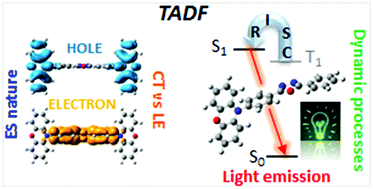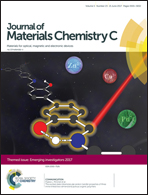Dynamic nature of excited states of donor–acceptor TADF materials for OLEDs: how theory can reveal structure–property relationships†
Abstract
Spin statistics greatly limits the efficiency of OLEDs, which might be largely improved upon conversion of triplet into singlet-excited (and thus light-emitting) states via a Thermally Activated Delayed Fluorescence (TADF) process. We theoretically investigate here the combination of some real-life donor (D) and acceptor (A) moieties with the connectivity D–A and D–A–D. We selected phenoxazine (PXZ) and phenylthiazine (PTZ) as electron-donating groups, and 2,5-diphenyl-1,3,4-oxadiazole (OXD), 3,4,5-triphenyl-4H-1,2,4-triazole (TAZ), and 2,5-diphenyl-1,3,4-thiadiazole (TDZ) as their electron-accepting partners. The systematic Tamm–Dancoff Approximation-Density Functional Theory calculations performed allowed us to calculate accurately not only the energy levels of low-lying singlet and triplet-excited states, but also to characterize their Charge-Transfer (CT) or Locally Excited (LE) nature, since the energy difference and the coupling between the 3CT, 3LE, and 1CT states become key to understanding the molecular mechanism involved in this process. We have also studied the role played by the conformational landscape, arising from the thermally accessible range of D–A(–D) torsion angles, in the singlet–triplet energy gap as well as its influence on oscillator strengths. Overall, we rationalize the origin of the higher efficiencies found in real devices for D–A–D molecules, disclosing the underlying structure–property relationships and thus anticipating successful design strategies.

- This article is part of the themed collection: Journal of Materials Chemistry C Emerging Investigators


 Please wait while we load your content...
Please wait while we load your content...